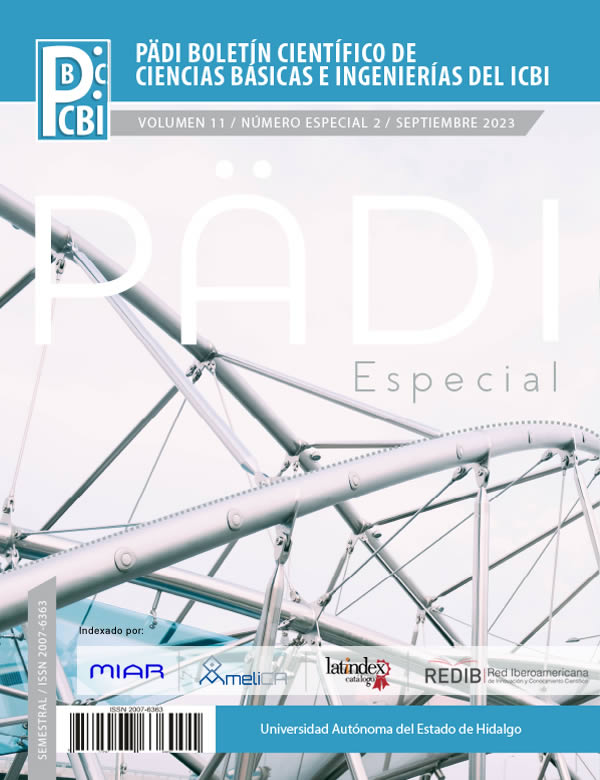Detección del nivel de estrés hídrico en plantas de lechuga romana a través de CNN
DOI:
https://doi.org/10.29057/icbi.v11iEspecial2.10943Palabras clave:
Redes Neuronales Convolucionales, Reconocimiento y Clasificación de Imágenes, Agricultura de PrecisiónResumen
La agricultura en México enfrenta importantes desafíos en el área del agua. Una alternativa para enfrentar este problema es la implementación de técnicas agrícolas modernas que permitan métodos de agricultura de precisión en invernaderos que puedan producir durante todas las estaciones del año y con un uso más eficiente del agua. Para ello son necesarios sistemas inteligentes que permitan monitorear y controlar los recursos para el crecimiento de las plantas de acuerdo a las condiciones que presenten. Este artículo describe el diseño y entrenamiento de una red neuronal convolucional (CNN) para detectar el grado de deshidratación de plantas de lechuga romana a través de imágenes. Los experimentos muestran una precisión y sensibilidad del modelo del 83% en la identificación del nivel de deshidratación y del 98,8% en ambas métricas, considerando una tolerancia de más/menos un nivel de diferencia con respecto al real.
Descargas
Información de Publicación
Perfiles de revisores N/D
Declaraciones del autor
Indexado en
- Sociedad académica
- N/D
Citas
Arsenovic, M., Karanovic, M., Sladojevic, S., Anderla, A., y Stefanovic, D. (2019). Solving current limitations of deep learning based approaches for plant disease detection. Symmetry, 11(7).
Aversano, L., Bernardi, M. L., y Cimitile, M. (2022). Water stress classification using convolutional deep neural networks. JUCS - Journal of Universal Computer Science, 28(3):311–328.
Baranwal, S., Khandelwal, S., y Arora, A. (2019). Deep learning convolutional neural network for apple leaves disease detection. SSRN Electronic Journal.
Bechtsis, D., Moisiadis, V., Tsolakis, N., Vlachos, D., y Bochtis, D. (2017). Scheduling and control of unmanned ground vehicles for precision farming: A real-time navigation tool. En HAICTA, pp. 180–187.
Conagua (2020). Programa Nacional Hídrico 2020-2024, Comisión Nacional del Agua, Secretaría de Medio Ambiente y Recursos Naturales Cd. de México, México.
Conagua (2022). Numeragua Edición 2022, Comisión Nacional del Agua, Secretaría de Medio Ambiente y Recursos Naturales, Cd. de México, México.
Concepcion II, R., Lauguico, S., Almero, V. J., Dadios, E., Bandala, A., y Sybingco, E. (2020). Lettuce leaf water stress estimation based on thermovisible signatures using recurrent neural network optimized by evolutionary strategy. En 2020 IEEE 8th R10 Humanitarian Technology Conference (R10-HTC), pp. 1–6.
FAO e ITO (2018). E-agriculture in action: drones for agriculture, Food and Agric. of the U. N. and Intl. Telecomm. Union, Bangkok.
FAO e ITO (2021). Digital agriculture in action: artificial intelligence for agriculture, Food and Agric. of the U. N. and Intl. Telecomm. Union, Bangkok.
Fernandes, H., Moriones, E., Garcia, A., Barrero Mendoza, O., y Albiero, D. (2020). Agricultural unmanned ground vehicles: A review from the stability point of view. REVISTA CIENCIA AGRONOMICA, 51.
Gonzalez-de Santos, P., Fernandez, R., Sepúlveda, D., Navas, E., y Armada, M. (2020). Unmanned Ground Vehicles for Smart Farms. Idris, I. y Sani, M. (2012). Monitoring and control of aeroponic growing system for potato production. pp. 120–125.
Inegi (2020). Censo de población y vivienda 2020, Instituto Nacional de Estadística y Geografía, México. Kai, T., Li, J., Zeng, J., Asenso, E., y Zhang, L. (2019). Segmentation of tomato leaf images based on adaptive clustering number of k-means algorithm. Computers and Electronics in Agriculture, 165.
Kamarudin, M. e Ismail, Z. (2022). Lightweight deep cnn models for identifying drought stressed plant. IOP Conference Series: Earth and Environmental Science, 1091:012043.
Lakhiar, I., Jianmin, G., Syed, T., Chandio, F. A., Buttar, N., y Qureshi, W. (2018). Monitoring and control systems in agriculture using intelligent sensor techniques: A review of the aeroponic system. Journal of Sensors, 2018:18.
Mammarella, M., Comba, L., Biglia, A., Dabbene, F., y Gay, P. (2021). Cooperation of unmanned systems for agricultural applications: A theoretical framework. Biosystems Engineering, 223:61–80.
Montoya, A., Obando, F., Morales, J., y Vargas, L. (2017). Automatic aeroponic irrigation system based on arduino’s platform. Journal of Physics: Conference Series, 850:012003.
Naji, I. (2020). The drones impact on precision agriculture, Master thesis, University of Texas, El Paso, U.S. NASA (2006). Progressive plant growing has business blooming. Environmental and Agricultural Resources. New York: NASA Spinoff, pp. 64–77.
Ngugi, L., Abelwahab, M., y Abo-Zahhad, M. (2020). Recent advances in image processing techniques for automated leaf pest and disease recognition - a review. Information Processing in Agriculture, 8.
Ochoa-Noriega, C., Aznar-Sánchez, J. A., Velasco Muñoz, J., y Álvarez, A. (2020). The use of water in agriculture in mexico and its sustainable management: A bibliometric review. Agronomy, 10:1957.
Rahman, R., Arko, P., Ali, M. E., Khan, M., Apon, S. H., Nowrin, F., y Wasif, A. (2020). Identification and recognition of rice diseases and pests using convolutional neural networks. Biosystems Engineering, 194:112–120.
Sharif, M., Khan, M., Iqbal, Z., Azam, F., Lali, M. I., y Javed, M. (2018). Detection and classification of citrus diseases in agriculture based on optimized weighted segmentation and feature selection. Computers and Electronics in Agriculture, 150.




















